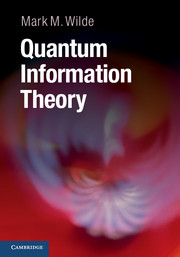Book contents
- Frontmatter
- Contents
- How To Use This Book
- Acknowledgments
- Part I Introduction
- Part II The Quantum Theory
- Part III Unit Quantum Protocols
- Part IV Tools of Quantum Shannon Theory
- 9 Distance Measures
- 10 Classical Information and Entropy
- 11 Quantum Information and Entropy
- 12 The Information of Quantum Channels
- 13 Classical Typicality
- 14 Quantum Typicality
- 15 The Packing Lemma
- 16 The Covering Lemma
- Part V Noiseless Quantum Shannon Theory
- Part VI Noisy Quantum Shannon Theory
- Appendix A Miscellaneous Mathematics
- Appendix B Monotonicity of Quantum Relative Entropy
- References
- Index
9 - Distance Measures
from Part IV - Tools of Quantum Shannon Theory
Published online by Cambridge University Press: 05 May 2013
- Frontmatter
- Contents
- How To Use This Book
- Acknowledgments
- Part I Introduction
- Part II The Quantum Theory
- Part III Unit Quantum Protocols
- Part IV Tools of Quantum Shannon Theory
- 9 Distance Measures
- 10 Classical Information and Entropy
- 11 Quantum Information and Entropy
- 12 The Information of Quantum Channels
- 13 Classical Typicality
- 14 Quantum Typicality
- 15 The Packing Lemma
- 16 The Covering Lemma
- Part V Noiseless Quantum Shannon Theory
- Part VI Noisy Quantum Shannon Theory
- Appendix A Miscellaneous Mathematics
- Appendix B Monotonicity of Quantum Relative Entropy
- References
- Index
Summary
We discussed the major noiseless quantum communication protocols such as teleportation, super-dense coding, their coherent versions, and entanglement distribution in detail in Chapters 6, 7,and 8. Each of these protocols relies on the assumption that noiseless resources are available. For example, the entanglement distribution protocol assumes that a noiseless qubit channel is available to generate a noiseless ebit. This idealization allowed us to develop the main principles of the protocols without having to think about more complicated issues, but in practice, the protocols do not work as expected under the presence of noise.
Given that quantum systems suffer noise in practice, we would like to have a way to determine how well a protocol is performing. The simplest way to do so is to compare the output of an ideal protocol to the output of the actual protocol using a distance measure of the two respective output quantum states. That is, suppose that a quantum information-processing protocol should ideally output some quantum state ∣ψ⟩, but the actual output of the protocol is a quantum state with density operator ρ. Then a performance measure P(∣ψ⟩,ρ) should indicate how close the ideal output is to the actual output. Figure 9.1 depicts the comparison of an ideal protocol with another protocol that is noisy.
This chapter introduces two distance measures that allow us to determine how close two quantum states are to each other.
- Type
- Chapter
- Information
- Quantum Information Theory , pp. 203 - 231Publisher: Cambridge University PressPrint publication year: 2013
- 1
- Cited by

